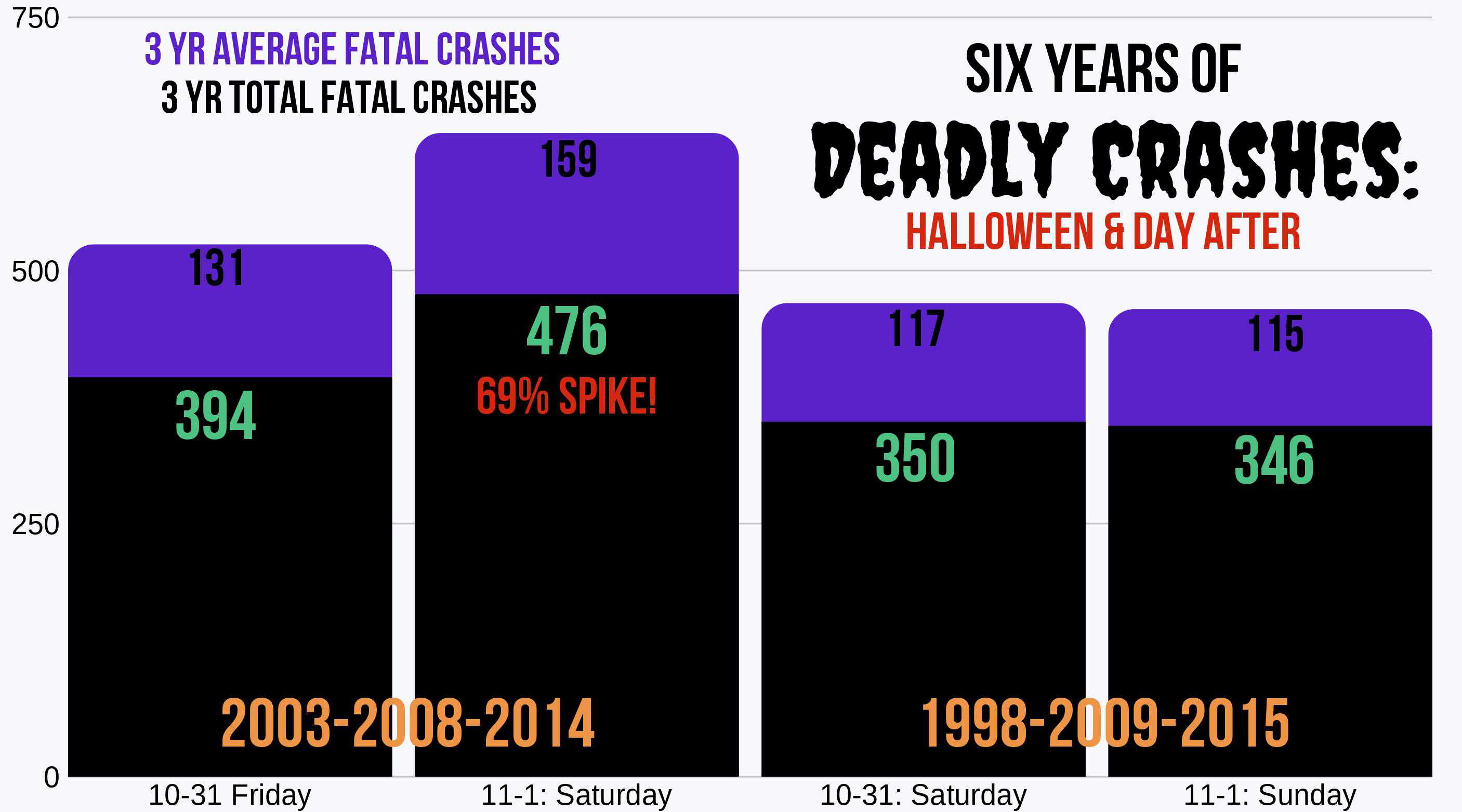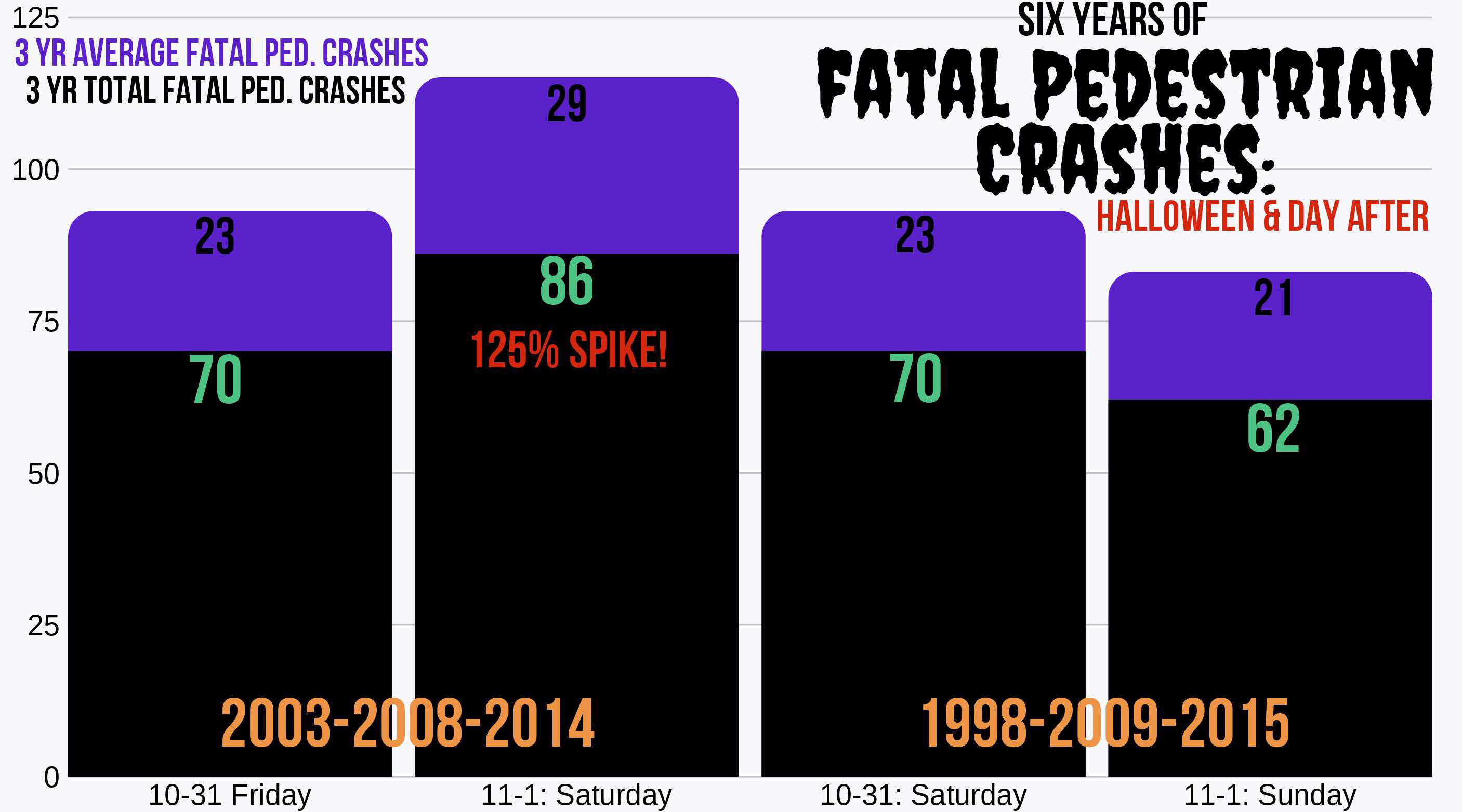Halloween Car Accident Statistics: Deadliest Days for Halloween in 25 Years
Friday is the deadliest day for Halloween, with 22% more fatal crashes compared to an average Friday. Since Halloween car accident statistics show the most dangerous days are also Tuesdays (2nd), Sundays (3rd), and Thursdays (4th) — we make the case for why Halloween should be moved to Saturday.
Free Car Insurance Comparison
Compare Quotes From Top Companies and Save
Secured with SHA-256 Encryption
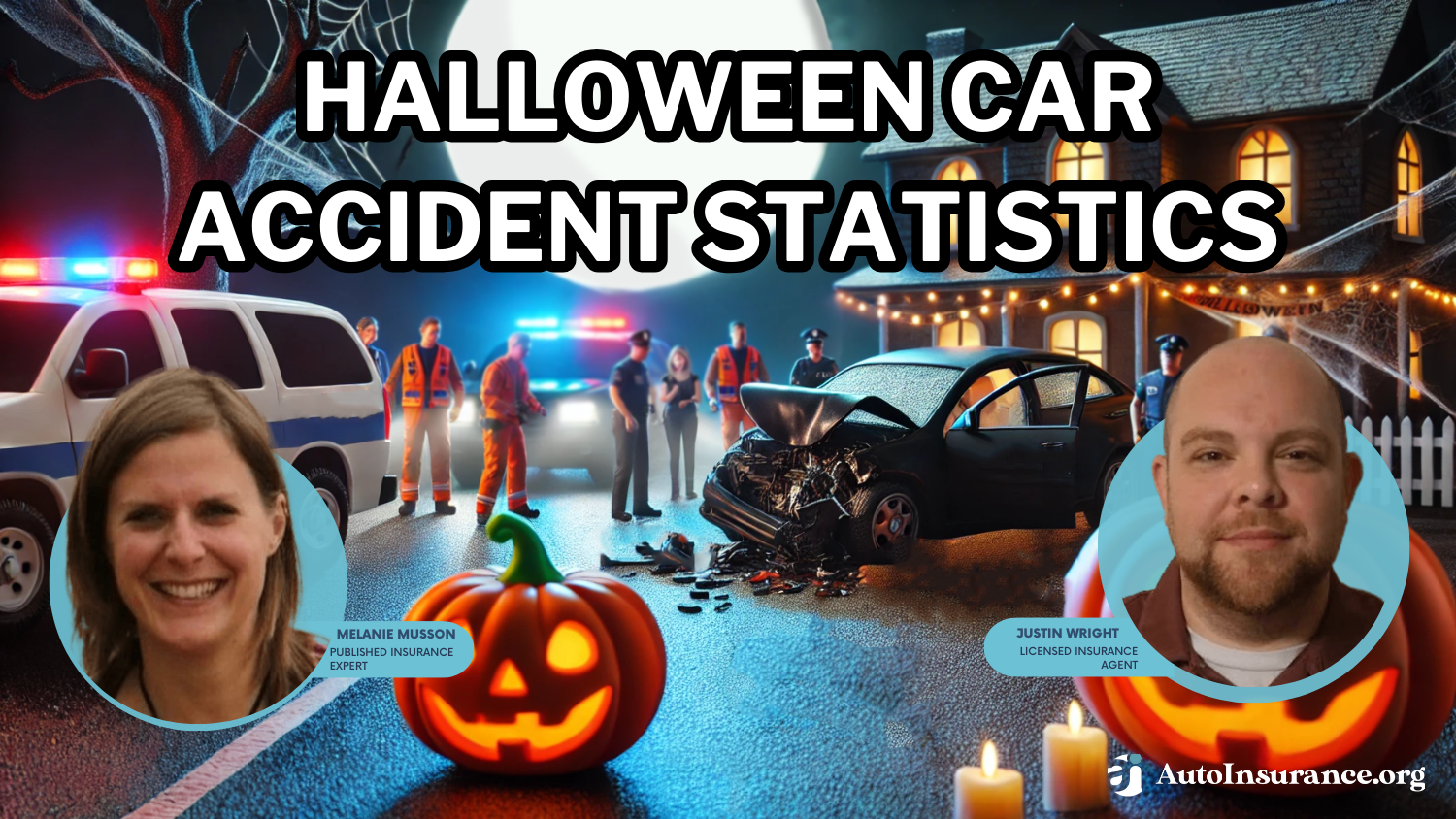
Justin Wright
Licensed Insurance Agent
Justin Wright has been a licensed insurance broker for over 9 years. After graduating from Southeastern Seminary with a Masters in Philosophy, Justin started his career as a professor, teaching Philosophy and Ethics. Later, Justin obtained both his Property & Casualty license and his Life and Health license and began working for State Farm and Allstate. In 2020, Justin began working as an i...
Licensed Insurance Agent
UPDATED: Oct 27, 2024
It’s all about you. We want to help you make the right coverage choices.
Advertiser Disclosure: We strive to help you make confident auto insurance decisions. Comparison shopping should be easy. We are not affiliated with any one auto insurance provider and cannot guarantee quotes from any single provider. Our partnerships don’t influence our content. Our opinions are our own. To compare quotes from many different companies please enter your ZIP code on this page to use the free quote tool. The more quotes you compare, the more chances to save.
Editorial Guidelines: We are a free online resource for anyone interested in learning more about auto insurance. Our goal is to be an objective, third-party resource for everything auto insurance related. We update our site regularly, and all content is reviewed by auto insurance experts.
UPDATED: Oct 27, 2024
It’s all about you. We want to help you make the right coverage choices.
Advertiser Disclosure: We strive to help you make confident auto insurance decisions. Comparison shopping should be easy. We are not affiliated with any one auto insurance provider and cannot guarantee quotes from any single provider. Our partnerships don’t influence our content. Our opinions are our own. To compare quotes from many different companies please enter your ZIP code on this page to use the free quote tool. The more quotes you compare, the more chances to save.
On This Page
Halloween is a night filled with trick-or-treating and candy, where kids dressed as ghouls and skeletons collect peanut butter bars and cookies. Despite its festive nature, it’s important to consider Halloween deaths statistics and recognize that Halloween can be a dangerous holiday.
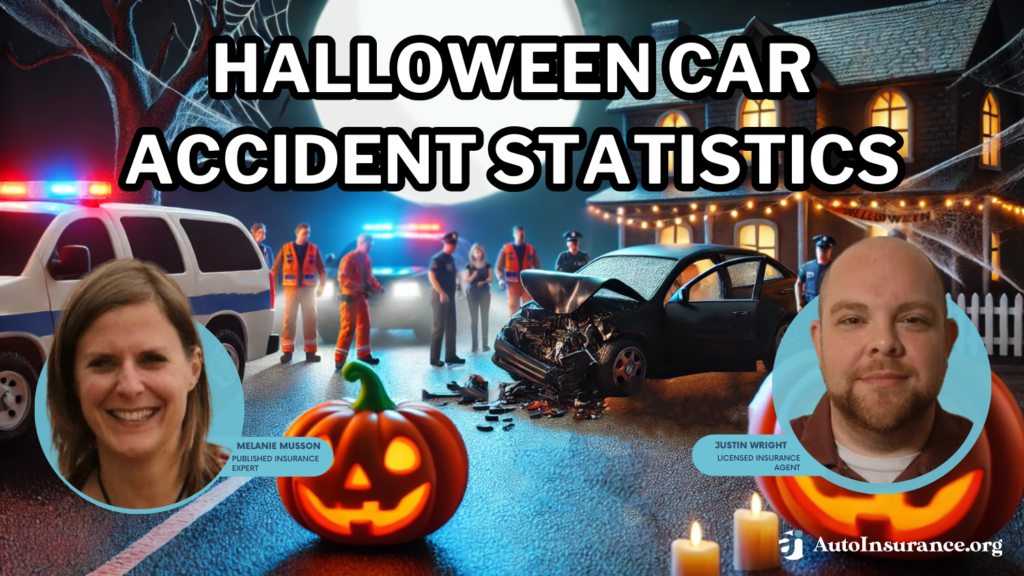
Although this holiday is family-friendly on one end, there is a dark side to partying and drinking. These two sides often meet on the streets of neighborhoods where partygoers drink and drive and threaten the lives of trick-or-treaters or pedestrians.
But what if there were a solution to this problem?
In this article examining the deadliest days for Halloween, we delve into the increasing advocacy for moving Halloween to a Saturday. By analyzing the most hazardous Halloweens over the past 25 years, we aim to assess whether the push to move Halloween to Saturday is supported by data. We’ll also consider the reasons for Halloween falling on a Saturday and its impact on Halloween day.
The graphic below shows the 10 most dangerous Halloweens in the past 25 years. You’ll see that just two of them fall on a weekend and none of them are on a Saturday.
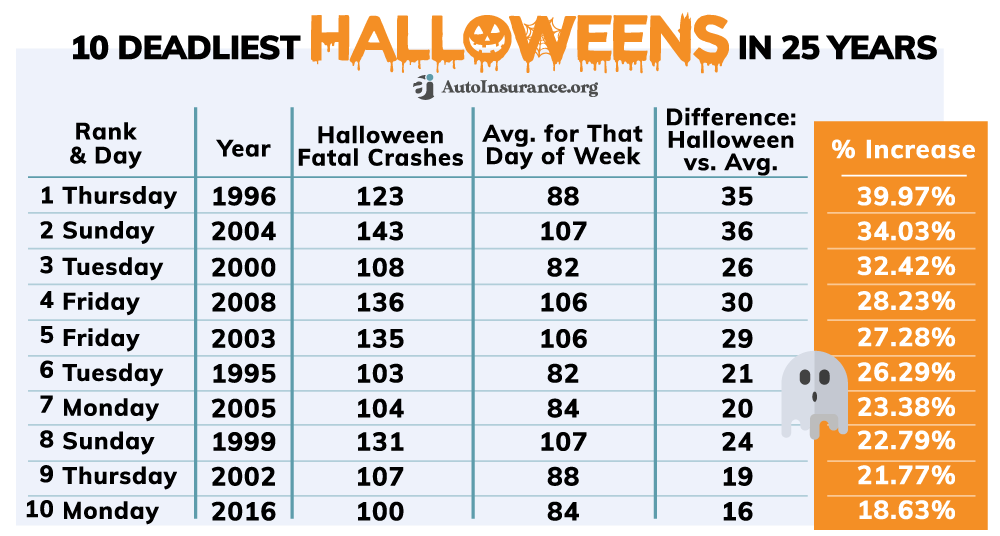
If you’re on this page, you’re likely interested in understanding how fatal crashes on Halloween impact auto insurance. We cover this topic in detail, including the implications of having insurance with the worst companies if you’re involved in an accident. Additionally, we address how the last Halloween Saturday, the highest crime rate, and the Halloween Friday date might influence your coverage.
If you plan on driving during Halloween, you run the risk of getting into an accident. What are the different types of auto insurance you might need to protect yourself? Knowing the coverages you need can save you money down the road. This is true on Halloween too.
Before you dig in, see how to lower your auto insurance premium. Enter your ZIP code into our free tool to get started.
So, which are the deadliest days for Halloween, as captured in our 25-year study? Let’s get started.
- 18% of the people who die in fatal crashes on Halloween are children
- Pedestrians have a 50% higher chance of dying on Halloween than on the average day
- Weekday Halloweens have 11% more fatal crashes than weekend Halloweens
- Over 149,000 Americans signed a petition to permanently move Halloween to Saturday
Deadliest Halloweens for Children in the Past 15 Years
Unfortunately, Halloween presents specific risks for pedestrians and children, particularly during the night. The combination of drunk or distracted drivers and dark costumes creates hazards for both motorists and pedestrians. It’s important to be aware of Halloween Saturday dates, Halloween kidnapping statistics, and Halloween pedestrian accident statistics to stay informed and safe.
The chart below illustrates Halloween safety statistics over the past 15 years, detailing the number of children killed in car accidents each Halloween. The second-to-last column displays the total number of fatalities on these dates, while the final column shows the percentage of these victims who were children. The Halloween date is highlighted to provide context for the data, which also considers the impact of factors like drunk drivers in Halloween costumes.
The percentage of children that are killed out of all people killed in car crashes on Halloween night varies quite a bit.
On the low end, just two out of the 43 people killed in traffic accidents on Halloween night in 2019 were children (4.65%). On the high end, 14 out of 29 people killed on Halloween night in traffic accidents during 2014 were children (48.28%).
There were also 14 child deaths out of the 39 total in 2006, making it the second deadliest Halloween for children (35.9%). However, since 1995, the majority of Halloween nights totaled between five and nine child deaths in traffic accidents.
While you might think that weekends would be the worst culprit here, the data shows that weekdays (Monday-Friday) comprise eight out of the worst 10 spots with an average of 18.78% of traffic deaths being children. Saturday and Sunday Halloween nights see just 11.92% of traffic deaths being children.
Statistics on Halloween accidents, particularly as far as age groups go, serve as a stark reminder for parents to discuss Halloween night safety with their children. Halloween is considered one of the deadliest holidays in the USA, and the risk of a car accident on Halloween underscores the importance of these safety conversations.
Free Auto Insurance Comparison
Enter your ZIP code below to view companies that have cheap auto insurance rates.
Secured with SHA-256 Encryption
The Deadliest Day for Halloween Involving Pedestrians
We know that Halloween can be dangerous for children, so how about pedestrians as a whole? To find out, we looked at the percentage of accidents involving pedestrians from 2005 to 2019. That number: 15.18%. How does this compare to Halloweens?
The table below shows the percentage of accidents pedestrians have been involved in on Halloween night for that same period, ranked by severity. The average is 28.48%.
Pedestrians Involved in Fatal Crashes on Halloween [2005-2019]
Crashes | Involved | Involved |
||
|---|---|---|---|---|
The lowest percentage is 21.21% in 2008 and the highest is 41.67% in 2017. Both are dramatically higher than the general percentage. If you compared the weekends to weekdays, you can see that a pedestrian has a higher chance of being involved in a fatal crash on a weekday than on a weekend:
- Saturday-Sunday percentage of pedestrian-involved fatal crashes: 26.67%
- Monday-Friday percentage of pedestrian-involved fatal crashes: 28.84%
Both are high and neither is great. Weekends still prove to be safer, however, for pedestrians on Halloween night.
Weekday vs. Weekend Halloween Fatal Car Crashes
Yes, Halloween nights can pose a specific danger for children and pedestrians, especially during the week. But are they dangerous for everyone?
Take a look at the following graphic, which shows the difference in fatal crashes that happen on Halloween nights versus those nights in general. It gets ugly during the week, much more so than on the weekend.
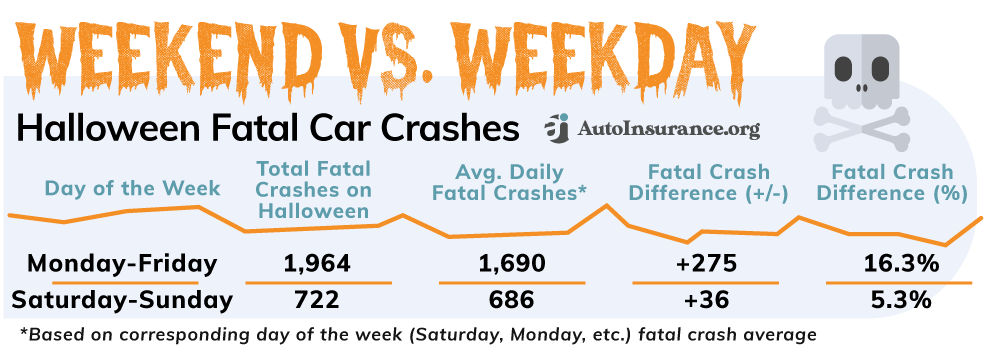
It appears that Halloween falls on weekdays are more hazardous compared to weekends. When Halloween occurs between Monday and Friday, there’s a notable increase of 16.30% in fatal crashes compared to the average fatal crashes on similar non-Halloween days. This trend suggests that Halloween Kills do badly on weekdays and raises concerns about whether there has ever been a Halloween killer associated with such increased risks.
Halloweens that fall on Saturday and Sunday see a rise of just 5.30% in fatal crashes compared to the average fatal crashes on a regular Saturday or Sunday.
Now, we’ve established that Halloweens falling on weekdays are worse for children, pedestrians, and the general population. Drunk driving is a big deal on Halloween nights and as we saw in our study “Drunk Driving Rates by State,” some states fare better than others.
Read more: DUI Defined
Understanding the risks in your area can help you create a more effective plan for Halloween or other holiday nights. Next, we’ll explore which day of the week is the deadliest overall for Halloween. Additionally, we’ll consider how many kills are in Halloween Kills and evaluate whether Halloween Kills is good or bad.
Deadliest Day for Halloween Overall
To determine the deadliest day of the week for Halloween, we looked at the number of fatal crashes that fell on a Halloween day compared to that day on average. So, Tuesday Halloween fatal crashes versus the number of fatal crashes on an average Tuesday. What we found may shock you:
Friday is the most dangerous night for Halloween, with Friday Halloweens seeing 21.86% more fatal crashes compared to the average Friday.
The safest night for Halloweens is Saturday, with Saturday Halloweens seeing 4.34% fewer fatal crashes compared to the average Saturday.
The full list is:
- Monday: +13.89%
- Tuesday: +18.01%
- Wednesday: +8.42%
- Thursday: +15.51%
- Friday: +21.86%
- Saturday: -4.34%
- Sunday: +15.60%
Now, overall, what have been the most dangerous Halloweens since 1995?
Free Auto Insurance Comparison
Enter your ZIP code below to view companies that have cheap auto insurance rates.
Secured with SHA-256 Encryption
5 Deadliest and Safest Halloweens Since 1995
How dangerous is dangerous when it comes to Halloween? The table below ranks the worst five Halloweens over the past 25 years:
Deadliest Halloweens Over the Past 25 Years [1995 - 2019]
Each of the Halloweens had over 27% more fatal crashes than on an average day, with the worst of the worst being Halloween on Thursday in 1996. That Halloween saw a jump of nearly 40% in fatal crashes.
Fortunately, our progress over the past 25 years hasn’t been all downhill. Here are the safest Halloweens, with each seeing a drop in fatal crashes compared to the average.
Safest Halloweens Over the Past 25 Years [1995-2019]
All of the safest Halloweens had at least 4.43% fewer fatal crashes compared to that corresponding day’s fatal crash average. Two Halloween Saturdays saw fatal crash totals at least 11% less than that day’s average.
Why Halloween Should Be Moved to Saturday
12% of children (5 and under) go trick-or-treating without adult supervision on the same day which sees a 9% increase from the daily average of fatal crashes.
Is it difficult for you to get home, eat dinner, and get in costume to join your family for trick-or-treating? Or are you one of the millions of Americans who work second or third shift and have to miss Halloween entirely this year?
The problems surrounding Halloween don’t end there. Most people have to get up early for work or school the next day, which is also a weekday this year.
Many adults and children alike dread when one of their all-time favorite holidays falls on a weekday. Sadly, when Halloween is a floating number on the calendar, it will fall on a weekday 71% of the time.
And, that’s not to mention an even bigger problem. Yes, walking around in costumes on the streets in the dark is downright spooky, which might feel fitting, but is it safe? Can all those vehicles see you and your kids when you cross the street to get to more houses?
No, it is not safe and we have 24 years of crash data to prove it. Check out this list of holidays with the most fatal crashes.
In response to these time conflicts and safety concerns, The Halloween & Costume Association (HCA) created a petition back in 2018 to move Halloween to the last Saturday in October. The primary goal is to create a safer, longer Halloween for families to enjoy together by utilizing daylight hours on a series of two days that most Americans have off of school and work.
Our research experts analyze the worst states for traffic-related fatalities all year long to determine trends and alert the public of major safety concerns. Halloween has been on our radar as being a deadly day for drivers, passengers, and pedestrians for a while now. We would like to join and support the recent momentum to move Halloween to Saturday with some cold, hard fatal crash facts.
10 Reasons: Why should Halloween be on a Saturday?
Should Halloween be on a Saturday? There are more than 10 reasons to move Halloween to the last Saturday in October, but we feel the below historically proven facts are enough to win the debate all on their own. To back this opinion piece, our researchers analyzed 24 years of traffic accident reports provided by the NHTSA.
We may not have 1 million Snickers bars to offer you, but we can give you the necessary facts you need to form an educated opinion on this controversial topic. At the very least, the statistics below should help motivate you to safeguard your loved ones while celebrating Halloween each year.
#1 – Weekday Halloweens are Deadly for Children
Halloween creates life-threatening dangers to the youth of our nation that cannot be ignored. The fatal crash statistics are both heartbreaking and eye-opening. Halloween is ranked as the seventh most fatal holiday on the list of the 10 deadliest holidays to drive.
On average, when Halloween occurs on a weekday, there’s an 82.6% increase in fatal Halloween accidents involving children (aged 17 and under) after 4 p.m.
From 1994 to 2017 the 18 times that Halloween occurred on a weeknight, the number of fatal traffic accidents involving children jumped from 10 to 18. This means that weeknight Halloweens cause about eight more deadly crashes involving children than the average weeknight.
#2 – Weekday Halloweens are Deadly for Pedestrians
For 24 consecutive years, every single weekday Halloween experienced significant increases in fatal crashes involving pedestrians—fatal crashes in which at least one person was killed.
The 18 times that Halloween occurred on a Monday-Friday since 1994, there was an average 55% increase in fatal car crashes where one or more pedestrian was severally injured or killed.
In 2017, when Halloween fell on a Tuesday, 7,450 pedestrians were killed in the U.S. The National Safety Council reports that nearly 18% of those deaths occurred at road crossings or intersections.
#3 – Weekday Halloweens Increase Fatal Crashes
On the 18 weekday Halloweens from 1994 to 2017, there was a 9% average increase in fatal crashes. This equates to an average of 8.4 more fatal crashes on those weekday Halloweens than the daily average for the whole year.
In 24 years, one-third of the weekday Halloweens had a 20% or higher increase in fatal crashes. On all six of those Halloweens, there were at least 16 more fatal crashes than the typical daily average.
Let that sink in for a moment. One “fun” day caused sixteen more fatal crashes than the typical day for that year. Remember, one fatal crash often results in multiple injuries and deaths.
#4 – Friday Halloweens have the Largest Fatal Crash Spikes
Halloween and Friday make for a downright deadly combination. We could adequately make the case to move Halloween to Saturday just by pointing out how deadly Halloweens on Friday have been.
Since 1994, every time Halloween occurred on a Friday, there was a 36% in fatal traffic accidents on average.
Every single Halloween that fell on a Friday in 24 years, there were at least 21 more fatal car accidents than what was typical for that year.
In 2008, the deadliest Halloween yet, there were 43 more fatal crashes than the daily average. Here’s the actual crash count: the daily fatal crash average in 2008 was 93, but on Friday, October 31st, there were 136. These crash spikes speak for themselves.
#5 – Friday Halloweens are the Deadliest for Children
When looking specifically at fatal accidents that occurred on Halloween night (after 4 p.m.) involving children, 17 and under, the Halloween accident statistics are alarming. Once parents discover how deadly Friday Halloweens have been for children, we are confident they will want it permanently moved to Saturday.
Is a couple hours of fun and a bucket of candy (mostly from strangers) worth risking your child’s life? Of course not.
In 24 years, here’s the breakdown of the five deadliest Halloweens to date:
10 Deadliest Halloweens from 1994-2017
| Day and Year | Fatal Crashes | Annual Average | Fatal Crash Increase | Percent Difference |
|---|---|---|---|---|
| Friday, 2014 | 19 | 6.6 | 12.4 | +188% |
| Friday, 2003 | 30 | 11.6 | 18.4 | +158% |
| Friday, 2008 | 20 | 8.3 | 11.7 | +140% |
| Thursday, 1996 | 32 | 13.4 | 18.6 | +139% |
| Tuesday, 2006 | 23 | 10.3 | 12.7 | +122% |
As you can see, Friday was the first, second, and third deadliest Halloween night since 1994 for our nation’s youth. When Halloween falls on a Friday, we can expect there to be about three times the number of fatal traffic accidents involving children that evening.
#6 – Friday Halloweens Cause Two Days of Death Spikes
Again, we see that Friday Halloweens are so deadly they make the case for permanent Saturday Halloweens all on their own. When Halloween takes place on a Friday, there are shocking spikes in accidents resulting in deaths on not just one but two consecutive days. Take a look at the data in the chart below:
Friday and Saturday Crash Spikes from Halloween
| Day and Date | Fatal Crashes | Annual Average | Fatal Crash Increase | Percent Difference |
|---|---|---|---|---|
| Friday 10-31-1997 | 123 | 102.2 | 20.8 | +20% |
| Saturday 11-1-1997 | 165 | 102.2 | 62.8 | +61% |
| Friday 10-31-2003 | 135 | 105.4 | 29.6 | +28% |
| Saturday 11-1-2003 | 170 | 105.4 | 64.6 | +61% |
| Friday 10-31-2008 | 136 | 93.4 | 42.6 | +46% |
| Saturday 11-1-2008 | 174 | 93.4 | 80.6 | +86% |
| Friday 10-31-2014 | 123 | 82.2 | 40.8 | +50% |
| Saturday 11-1-2014 | 132 | 82.2 | 49.8 | +61% |
Every time that Halloween has occurred on a Friday in 24 years, there has been a 20-86% increase in fatal crashes on both Halloween day (Friday) and the day after (Saturday).
When Halloween is on Friday, people tend to party harder, drink more, stay up later, take more risks, take fewer precautions . . . and these dangerous Friday celebrations cause dangers that roll right into Saturday.
#7 – Saturday Halloweens Cause for a Safer Weekend
After studying 24 years of fatal crash data surrounding Halloween, it was undeniable that Halloween causes increases in deaths from traffic accidents involving pedestrians, children, and the average American adult. However, Halloweens that fell on Saturday created a much lower fatal crash increase across two days.
When Halloween fell on a Friday, the average fatal crash increase for Halloween and the day after was 52%. While Saturday Halloweens and the day after had an average increase of 27%.
Is that 25% difference in increase not very impressive to you? Comparing the last three Friday Halloweens to the last three Saturday Halloweens will be.
There were 174 more fatal crashes on the Friday/Saturday combo compared to the Saturday/Sunday Halloween weekend. Take a look at the below graph illustrating just how much more dangerous Friday Halloweens are:
#8 – Saturday Halloweens Are Safer for Pedestrians
The two-day string of fatal crashes involving pedestrians when Halloween falls on Friday is haunting.
The history crash reports prove that the late Friday night Halloween celebrations and trick-or-treating make for deadly roads – especially for pedestrians – the following day, November 1. See the pedestrian fatal crash totals and percent increases for the last four Friday Halloweens:
Friday and Saturday Pedestrian Fatal Crash Spikes from Halloween
| Day and Date | Pedestrian Fatal Crashes | Annual Average | Pedestrian Fatal Crash Increase | Percent Difference |
|---|---|---|---|---|
| Friday 10-31-1997 | 17 | 14.4 | 2.6 | +18% |
| Saturday 11-1-1997 | 28 | 14.4 | 13.6 | +94% |
| Friday 10-31-2003 | 23 | 13 | 10 | +77% |
| Saturday 11-1-2003 | 24 | 13 | 11 | +85% |
| Friday 10-31-2008 | 24 | 12 | 12 | +101% |
| Saturday 11-1-2008 | 29 | 12 | 17 | +142% |
| Friday 10-31-2014 | 23 | 13.4 | 9.6 | +72% |
| Saturday 11-1-2014 | 33 | 13.4 | 19.6 | +147% |
Interestingly, there was the same total number of fatal traffic accidents involving pedestrians on the last three Friday Halloweens as there were on the last three Saturday Halloweens: 70 each. The scary spike in pedestrian fatalities, however, was seen the day after Halloween. Check out the graph below:
It’s undeniable the dangers Halloween causes. The three-year average increase in fatal accidents involving pedestrians the day after the Friday Halloweens was 125%.
While Halloween has been shown to result in increased pedestrian fatal crashes regardless of what day it occurs, Halloween on Saturday has been much safer historically. Below are some helpful safety tips you should follow this Halloween. Do your part to help bring down those chilling death counts.
Read more: Safest States for Pedestrians
#9 – Sunday Will Allow for a Sugar Recovery Day
The traffic accident reports show that Sunday is a safer day than most days for both deadly car accidents in general and car accidents resulting in deaths that involve pedestrians.
From 1994 to 2017 there were 1,253 Sundays, and over 27% of those Sundays experienced a decrease in fatal car accidents compared to the daily average for that year.
Plus, every year from 2013 to 2017, there was a decrease in fatal traffic accidents involving pedestrians on Sundays compared to the daily average for that year. See the specifics for each year below:
Sunday Pedestrian Fatal Crashes 2013-2017
| Year | Average Pedestrian Fatal Crashes | Annual Avg: Pedestrian Fatal Crashes | Percent Difference |
|---|---|---|---|
| 2013 | 12 | 13 | -4% |
| 2014 | 13 | 13.4 | -6% |
| 2015 | 14 | 15 | -2% |
| 2016 | 16 | 16.5 | -1% |
| 2017 | 15 | 16.3 | -6% |
Sundays offer a safer, relaxing day for adults and children to recover from the higher sugar intake and partying from the night before.
#10 – On Weeknights, People Rush Over Safety
Moving Halloween to Saturday makes for a less rushed, more enjoyable celebration where parents have more time and energy to take the extra steps necessary to keep their family safe while out trick-or-treating.
Each year there are about 4,500 Halloween-related injuries in the U.S. alone.
And, here are some more statistics provided by change.org illustrating why these injuries are so common on Halloween:
- 82% of parents don’t utilize visibility aids such as reflective tapes or glow sticks while trick-or-treating
- 65% of parents don’t discuss safety while out on Halloween
- 63% of children don’t carry a flashlight while trick-or-treating
- 12% of children (5 and under) go trick-or-treating without adult supervision
That last statistic is ominous. Twelve percent of America’s youngest kids – aged 0 to 5 – are alone, outside in the dark walking house to house likely with poor visibility due to their costumes.
Walking around alone at night when disguises are common, even expected, puts children at a much higher risk for violence and kidnapping.
As the video states at the end, “Not all monsters will look scary this Halloween.”Warn your kids of the dangers, take all the precautions you can, and stay close by them this Halloween, especially if the trick-or-treating takes place in the dark.
Free Auto Insurance Comparison
Enter your ZIP code below to view companies that have cheap auto insurance rates.
Secured with SHA-256 Encryption
More Horrifying Health Dangers of Halloween
While these deadly events can result no matter what day Halloween falls on, we still felt that this was the best time to warn you. Here are more reasons to keep your guard up whatever day you celebrate this special holiday that Irish immigrants brought to the U.S. in the 1800s.
- Kids are more prone to deadly allergic reactions from the goodies they get while trick-or-treating
- Halloween brings an increased risk of fires and burn injuries. Watch this terrifying video made by firefighters showing how kids’ costumes can burst into flames in a matter of three seconds or less.
- There is an increase in drunk driving on Halloween.
On Halloween, 14% of pedestrian deaths and 44% of people killed in car crashes all had a drunk driver to blame.
- Pumpkin carving injuries are far too common. In fact, 41% of all Halloween-related injuries in 2017 resulted from people trying to decorate pumpkins.
- Contacts worn as part of costumes on Halloween have left people blind. Take Julian’s story to heart. Even after 10 surgeries, he’s still blind in one eye thanks to $20 costume contacts. Still brave enough to try out creepy contacts to make your Halloween look pop? Watch the video below for tips from an eye doctor on where to buy them and how to properly care for them:
- Allergic reactions to face and body paint are very common on Halloween. Check the ingredient list on the paint you buy to make sure it’s FDA-approved, and always test the paint on a small area before applying it all over your face or large areas of your skin.
- All of the sugar that’s consumed on – and after – Halloween can do serious (and expensive) damage to your teeth. Here’s the motto the American Dental Association suggests you go by for Halloween candy: “Be picky if it’s sticky.”
A recent survey conducted by the National Confectioners Association found that 90% of Americans claim the chocolate and candy make Halloween more fun.
- We get it! America has a great big sweet tooth. But beware, those candy calories add up fast, and obesity is linked to all of the leading causes of death in our country. Remember, it will take you about an hour of walking to burn off a Snickers bar containing 215 calories.
- It’s not just humans that are at higher risk of danger during Halloween. Household pets are 32% more likely to experience life-threatening food poisoning during the week of Halloween compared to any other week in the entire year.
As you can see, the dangers associated with Halloween don’t end on the dark streets at night — they continue to lurk over the following days and even weeks. Our team of insurance experts at Autoinsurance.org wholeheartedly believes that moving Halloween and all trick-or-treating to Saturday will prevent unnecessary injuries and save hundreds of lives.
Halloween on Saturday = Safest Solution
Whether the actual day of Halloween is completely moved or a new holiday is created to occur on the last Saturday of October, something has to change. Trick-or-treating late at night in the dark is not safe especially when most Americans are tired and distracted from work and school earlier that day.
Twice as many children are killed while walking on Halloween than any other day of the year – we need to fix this.
Maybe you don’t have kids or are somehow unphased by the increased risks and traffic deaths. Even if you’re just a fan of Halloween for the parties and candy, there’s still reason for you to be a supporter of this movement; as Change.org put it:
“51% Of Millennials say Halloween is their favorite holiday, so why cram it into two rushed evening weekday hours when deserves a full day?”
The Halloween & Costume Association is pushing for a “Safer, Longer, Stress-Free Celebration” and so are we.
Moving Halloween to Saturday: 3 Supporting Statistics
To recap, here are three statistics that support the petition to move Halloween to a Saturday:
- Saturdays experience the only decline in fatal crashes on a Halloween at 4.34%
- Monday-Friday Halloweens show a rise in fatal crashes at 16.30%
- Weekend Halloweens show a much smaller increase in child deaths on Halloween
Now, let’s analyze the insurance impact.
Free Auto Insurance Comparison
Enter your ZIP code below to view companies that have cheap auto insurance rates.
Secured with SHA-256 Encryption
Impact of Car Crashes on Auto Insurance
Car crashes have a damaging impact on auto insurance rates, with some companies increasing annual rates by over $600 after one accident. The graph below ranks the auto insurance companies with the highest price increase after one accident.
You can see that Progressive is the worst with a jump of nearly 65.54% in rates after one accident. All five companies have jumps of at least 43.97% in rates, including Allstate, which has an average rate that jumps over $850.
Read more: What are the worst auto insurance companies?
Halloween has dangerous consequences for children, pedestrians, the general population, and auto insurance rates. Our conclusion, and what the data shows, is that moving Halloween to a Saturday is likely the best outcome for all involved.
Thought Leaders Weigh in on Halloween Driving Dangers
Here we have a diverse crew of thought leaders — from a lawyer to a trip advisor to a life coach — who talk about the dangers of Halloween driving and how you can say safe if you’re a partier or keep your children safe if you’re a parent.

What are some reasons that Halloween makes U.S. roads more dangerous than the average day?
“According to AAA and the NHTSA, Halloween is the single deadliest day of the year for child pedestrians. They are three times more likely to be struck and killed on Halloween than on any other day.
Contributing factors include kids on the roads, costumes that do not reflect light, distracted driving, impaired driving, and inadequate supervision, among other factors.”
How can partiers, if they need to drive, stay safe on Halloween?
“Here are some ways to stay safe on Halloween:
- Slow down in residential neighborhoods and obey all traffic signs and signals. Drive at least 5 mph below the posted speed limit to give yourself extra time to react to children who may dart into the street. Drive even slower than that if confronted by snow-covered or icy streets from recent winter storms.
- Look for children crossing the street. They may not be paying attention to traffic and may cross the street mid-block or between parked cars.
- Carefully enter and exit driveways and alleys.
- Turn your headlights on to make yourself more visible, even in daylight.
- Broaden your scanning by looking for children left and right in yards and on front porches.
- Never drive impaired.
- Never text and drive.
Read more:
If you have been drinking, using marijuana (in the states where it is recreationally lawful), or taking prescription medications, do not get behind the wheel, period. Call an Uber, Lyft, taxi, or friend to pick you up.”
How can parents keep their children safe while trick-or-treating on Halloween?
“Make sure Halloween costumes are flame-retardant and light in color to improve visibility.
Be bright at night: Wear retro-reflective tape on costumes and treat buckets and carry glow sticks and flashlights. Make sure your flashlights have new batteries ahead of time. Wear disguises that don’t obstruct vision. Instead, use non-toxic face paint. Also, watch the length of billowy costumes to avoid tripping.
Ensure any props are flexible and blunt-tipped to avoid injury from tripping or horseplay.
Ask an adult or older child to supervise children under age 12, and stay in a pack. Don’t allow any of the kids to stray away from the pack.
Instruct children to travel only in familiar areas and along established routes. Teach them to stop only at well-lit houses and never to enter a stranger’s home or garage.
Finally, review trick-or-treating safety precautions, including pedestrian and traffic safety rules.”
Do you think moving Halloween to Saturday would make the holiday less dangerous?
“I think that parents should be hyper-vigilant about creating a safe environment for their kids if they want to trick or treat. That includes dressing kids in light-colored, reflective, and flame-retardant costumes that do not obstruct their vision. At the same time, children under 12 should be carefully supervised and taught never to enter a stranger’s home or garage.
Halloweens results in an average 14% rise in fatal car crashes, regardless of what night the holiday falls. That said, my concern about moving it to Saturday is that I would expect more drivers and partiers on the road on a Saturday night, some of whom will be impaired, which would increase the danger to pedestrians, and particularly trick-or-treaters.”
Do you have a personal story about the dangers related to driving and Halloween that you would like to share?
“Yes. About 10 years ago, my wife and I took our two boys out to trick-or-treat in our neighborhood. We were walking in a pack crossing the street around a blind curve. It was a small neighborhood street.
As we were crossing, we heard the loud rumble of an engine. We quickly moved to a secure place on the sidewalk. As we did, a teenager in our neighborhood sped by in a hotrod, never seeing us.
The lesson we learned is that other people will often be the ones to do something dangerous. It’s up to you and your children to be prepared for that. Just like we are told to drive defensively on Halloween, and frankly, anytime, we should be ‘defensive pedestrians’ as well.”

Marc Lamber is a public safety advocate and personal injury lawyer.
He has 20 years of experience representing car accident victims.
What are some reasons that Halloween makes U.S. roads more dangerous than the average day?
“Reason 1: Drunk drivers from Halloween parties
When we think of the U.S., we usually think of Halloween. What we may not realize though, is that Halloween is one of the biggest party nights in the U.S. and the roads get temporarily filled with drunk drivers. Make sure you and your friends get home safely and call a sober friend if you need a ride.
Reason 2: More drivers and pedestrians out there
The hours between 3 and 11 p.m. are the most dangerous times to be on the road. As Halloween takes place between those hours, the risk of a car accident goes up even more. This is due to the fact that more drivers are out on the roadways, and there are more people out trick-or-treating and celebrating the holiday.
This makes the roadways more dangerous because there are more drivers and pedestrians out there at once, which increases the risk of an accident.
Reason 3: Drivers’ minds are not on the road
All the decorations, costumes, and parties can distract drivers. Plus, everyone is in a rush to get back to their parties after work, which also makes for more accidents.
This statistic shows the Halloween celebration plans of consumers in the United States in 2020 by gender. In 2020, 19% of female and 25% of male respondents stated they were planning to throw or attend a party as part of their Halloween festivities.”
How can partiers, if they need to drive, stay safe on Halloween?
“On Halloween, there’s a lot of partying, and people partake in excessive alcohol consumption, which can impair their vision and motor skills. But we can help prevent drunk driving and keep our communities and families safe by providing tips and resources and encouraging responsible behavior.
Partying with friends then driving home can put you or others at risk. If you plan to drink, then you should plan to designate a driver.
After you get to one party, try and leave some time to sober up before driving. Take a rest, breathe deeply, and drink some water, and make sure you aren’t driving while under the influence. And if some party is too far away or too dangerous to drive to, consider catching a ride with a sober driver or grabbing a taxi.
Pro tip: If you plan to host a party with alcohol involved, issue drink tickets to your guests before the party to limit excessive alcohol consumption. It will not only keep your guests from drunk driving but also help you budget appropriately.
If you need to be strict in your enforcement, print each ticket with the guest’s name and caution them before the party that drink tickets are non-transferable.”
How can parents keep their children safe while trick-or-treating on Halloween?
“Halloween is a big night for kids and parents. It’s a night of candy and costumes and scary stories. While it is the season for fun and candy and plenty of holiday cheer, there’s also the very real and very dangerous possibility of getting hurt. This is not just a concern for adults but also for children.
By following a few precautions, you can make sure that your child is safe from harm.
It’s important to plan a night where you can keep a close eye on your child in a safe neighborhood or have them go with a group of children rather than going alone. You can also have them wear a glow-in-the-dark bracelet, or you can give them a reflective vest or scarf to tie around their neck so they’ll be seen by cars.
Make sure you have a flashlight or headlamp if you plan to be out later than dusk. It’s also important to keep your phone on you.
In a survey conducted in September 2020 in the U.S., 65% of millennial parents were planning to allow their children to go trick-or-treating. That figure stood at 51% for Generation Z and Generation X parents.”
Do you think moving Halloween to Saturday would make the holiday less dangerous?
“I don’t think that moving Halloween to Saturday would have any effect on how dangerous it is. People are still just as likely to have parties with alcohol, have trick-or-treaters being careless crossing the street, have zombies drunk off their brains running around with no sense of self-preservation, etc.
All the dangerous things that go on Halloween would still occur on Saturday, so I don’t think it would have any effect on how dangerous the holiday is.”
Do you have a personal story about the dangers related to driving and Halloween that you would like to share?
“Although it’s not a personal story, I would like to share a Halloween experience from a young employee of my small business. Some years back, he had a little brother that was trick-or-treating with his friends. After trick or treating, they were walking home.
A driver was speeding down the street at around 10 p.m. He couldn’t see my employee’s brother, who was walking in front of his friends, with all the decorations still out on Halloween. The driver hit his brother. His brother was fine after the accident. He might have had a small cut on his head, but that was it. The driver was arrested for speeding.”
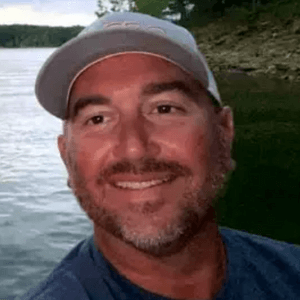
Robert Fleeman is an author and life coach.
He helps others learn to enjoy life while being responsible.
What are some reasons that Halloween makes U.S. roads more dangerous than the average day?
“Everyone who’s of legal drinking age is on party mode on Halloween night. And since many of these are house parties, a lot of these young people have a false sense regarding the safety of driving after having a few drinks, thinking that they live nearby each other.
And it’s these acts of negligence that cause many preventable road mishaps.”
How can partiers, if they need to drive, stay safe on Halloween?
“Get a designated driver who isn’t allowed even a drop of alcohol the whole night. If you all end up getting hammered, consider staying the night. And if you can’t handle your drink, stay off the booze.”
How can parents keep their children safe while trick-or-treating on Halloween?
“There’s only so much you can do, and in this case, pick them up yourself. Personally, I wouldn’t trust a teenager behind the wheel, especially when it comes to such parties.”
Read more: Six Reasons Why Auto Insurance Costs More for Young Drivers
Do you think moving Halloween to Saturday would make the holiday less dangerous?
“I don’t think so. As long as there is irresponsible behavior, these accidents will happen.
I once had a near-head-on collision experience on Halloween night in 2009. The other vehicle was practically driving in a zigzag towards my direction on a two-lane road.
Luckily, I was traveling at a normal speed and I was able to swerve out of harm’s way. I was still side-swiped and lost a side mirror, but it easily could’ve been worse.”

Jack Miller is the founder of How I Get Rid Of.
He has years of experience navigating busy, dangerous roads.
“Halloween is a time when children can enjoy dressing up in costumes and going door to door to collect treats. It is also a time when people can enjoy celebrating the spooky holiday. However, Halloween can also be a very dangerous day for children and adults alike.
The Most Dangerous Days for Halloween
Halloween is one of the most popular holidays in the United States. It is celebrated on October 31st each year.
Halloween is a night when people dress up in costumes and go trick or treating. There are also parties and events held throughout the day. Despite its popularity, Halloween can also be dangerous.
According to the National Safety Council, five days of the year are the deadliest for Halloween: October 1st, 2nd, 3rd, 5th, and 6th. During these days, there are more accidents and deaths than on any other day of the year.
This is because people drink alcohol and drive recklessly on these days. Alcohol-related accidents make up 30% of all fatalities during Halloween weekend.
Read more: What age group has the most fatal crashes?
It is important to be aware of what dangers exist around Halloween celebrations. If you plan to attend a party or go trick or treating, make sure to wear a costume that will protect you from unexpected weather conditions such as rain or snowfall. Also, be aware of your surroundings and avoid walking alone at night if possible.”
What are some reasons for the added dangers on Halloween?
“Halloween is a time of celebration, but it can also be a time of violence. What causes this violence? There are many factors that contribute to Halloween violence, some of which are cultural and historical.
Some experts say that the increased incidence of Halloween violence is due to the commercialization of the holiday. People see it as an opportunity to engage in criminal activity, such as theft or assault. In addition, people may be more likely to commit crimes on Halloween because they feel less inhibited than usual.
Halloween is a time when children and adults can enjoy dressing up and going door to door to collect treats. However, it is also a time when violence can often occur. It is important for families to take safety into their own hands during Halloween by following some simple tips.”

James Brooks is the CEO of CostumesHeaven.com.
His company provides custom-made costumes and apparel.
“Experiencing thousands of emotions is one of the best things a traveler loves. And one night full of emotions and fun is the night of trick-or-treating or Halloween.
For children and pedestrians, this holiday is great fun. For the drivers, however, it’s one of the most dangerous nights to drive as the children are walking on the road. There’s a lack of visibility, and since children are wearing different weird costumes, this can be distracting too. It’s advisable to drive slowly and be extra careful throughout your drive to avoid any mishap.
You should never drink and drive, especially on the night of Halloween.
The parents should keep watch and tell their children to stay in groups and walk on the sidewalks and crosswalks. Also, parents should have their children avoid any home that looks suspicious or vacant. Let your child carry a phone for safety reasons and tell them to be extra careful and go to the houses that are brightly lit.
Moving Halloween to a Saturday, despite what you may think, will make children more at risk of and prone to injuries. Since Saturday is on the weekend and people drink more on the weekend than on weeknights, this increases the risks of accidents and makes it more dangerous.
The biggest danger on Halloween is trick-or-treating. Kids are most excited about Halloween and due to this, they don’t even pay attention to their surroundings or traffic. Plus, it’s dark, which makes it dangerous for both children and adults in some way.”

Axel Hernborg is the CEO of Tripplo.
He provides safe travel tips and safety advice.
The Past 25 Halloween Statistics
Below is a table that shows the full statistics for all of the Halloweens in our study, dating back to 1995:
Free Auto Insurance Comparison
Enter your ZIP code below to view companies that have cheap auto insurance rates.
Secured with SHA-256 Encryption
Methodology: Analyzing the Danger of Halloween
For this study, we looked at every day for the past 25 years to gather numerous statistics:
- Number of fatal crashes
- Day of the week
- Daily average of fatal crashes for each year
After gathering those statistics, we determined the average fatal crashes for each day of the week, for each Halloween night, including day-before and day-after statistics, and the difference between the fatal crashes on Halloween vs. their respective day-of-the-week averages.
We also gathered separate statistics for children killed in fatal crashes and pedestrians involved in fatal crashes. All of these statistics came from the National Highway Traffic Safety Administration’s Crash Report Sampling System (CRSS).
With those statistics, we built the sections of the article and determined that Saturday is the best day for Halloween, far more so than any other day of the week.
Also, using fatal crash reports provided by the FARS division of the NHTSA, our team of experts compiled over 300,000 unique data points in three specific areas – all organized by month, day and year:
- Fatal Traffic Accidents Involving Pedestrians
- Fatal Traffic Accidents Involving Children Aged 17 and Under Occurring after 4 p.m.
- All Fatal Traffic Accidents Occurring Every Day from 1994-2017
Although our team has conducted thorough data-driven studies each month for nearly a decade, this particular study was one of the most in-depth to date as every single day for 24 years was compared to October 31 and November 1 to determine how Halloween and the day after affect the safety of American roads, pedestrians, and our youth.
Are you ready to shop for auto insurance? Enter your ZIP code in our free tool to compare insurance policies tailored to your needs.
Previous Results of This Study
Frequently Asked Questions
Is Halloween the most dangerous day of the year for driving?
Our statistics show that Halloween is not the most dangerous day of the year for driving, though it ranks No. 8 in our list of the deadliest holidays to drive with an average of 396 fatal crashes during its holiday period. It is routinely in the worst 10 of the deadliest holidays to drive and poses special dangers to children and pedestrians.
How many driving deaths are on Halloween?
It varies quite a bit depending on what day of the week it falls on, but over the past 25 years, Halloween fatal crashes have ranged from 143 (Sunday of 2004) to 77 (Thursday of 2019).
Overall, Halloween fatal crashes are showing a downward trend with the last three Halloweens (2017-2019) registering less than 90 fatal crashes overall.
Is Halloween a dangerous driving day?
Yes, Halloween is a dangerous driving day with it ranked as the 8th-most dangerous holiday to drive, just behind Mother’s Day and Cinco de Mayo.
Why should Halloween be moved to Saturday?
Halloween should be moved to Saturday to address safety concerns and conflicts with work and school schedules. Weekday Halloweens have been shown to be deadly for children and pedestrians, with significant increases in fatal crashes.
Moving Halloween to Saturday allows for a safer, longer celebration that can be enjoyed by families who have the day off.
How does moving Halloween to Saturday improve safety?
Moving Halloween to Saturday reduces the risks associated with trick-or-treating in the dark. Weekday Halloweens have shown a higher number of fatal accidents involving children and pedestrians.
By utilizing daylight hours on a weekend, there is better visibility and a lower likelihood of accidents. Saturday Halloweens have historically shown lower fatal crash increases and provide a safer environment for celebration.
What are the dangers of weekday Halloweens?
Weekday Halloweens have been associated with increased fatal accidents involving children and pedestrians. There is an average increase of fatal accidents after 4 p.m. on weekday Halloweens. The combination of costumes, darkness, and rush-hour traffic poses risks for children crossing the streets.
The data shows that weekday Halloweens have higher crash rates and pose a danger to individuals celebrating the holiday.
Are there specific days of the week that are more dangerous for Halloween?
Friday Halloweens have shown to be particularly deadly, with significant spikes in fatal traffic accidents. When Halloween falls on a Friday, there is a higher increase in fatal crashes than on other weekdays.
Friday Halloweens have also been found to be the deadliest for children, with a higher number of fatal accidents involving children on those days. These statistics highlight the need to move Halloween to a safer day like Saturday.
How does moving Halloween to Saturday compare to other days?
Moving Halloween to Saturday has shown to be a safer option compared to other days. Saturday Halloweens have lower fatal crash increases across two days compared to Friday Halloweens. When Halloween falls on a Saturday, there is a lower average increase in fatal crashes compared to Fridays.
Additionally, Saturday Halloweens have been safer for pedestrians, with fewer fatal accidents occurring on the day after Halloween.
What is the truth behind Halloween?
The tradition behind Halloween originated in a pagan festival called Samhain, celebrated in Ireland, Scotland, and the Isle of Man. During the festival, participants would create a bonfire, then wear masks to ward off ghosts.
Who does not celebrate Halloween?
Jehovah’s Witness participants, some Christians, and some Orthodox Jews all do not celebrate Halloween for various reasons.
Why is Halloween bad for driving?
Halloween poses unique challenges for drivers and pedestrians and especially between partygoers who drink and drive and children. The reason is that many partygoers, when Halloween falls on a weekday, may drink and drive.
Why do we say trick or treat?
Trick-or-treating is said to have originated from the custom in Ireland and Scotland of “guising” or “mumming,” where people recited a rhyme or performed a trick for a treat. It wasn’t always well-received in America, especially before the 1950s, but has since become synonymous with Halloween.
Why do teens still drink and drive?
Many teens still drink and drive because of inexperience when drinking and the effect alcohol can have on impacting decision-making. Because it disrupts decision-making processes, teenagers may underestimate the impact a drink is having on their ability to drive, such as alcohol’s known effect of slowing down reaction times.
Can you sue a minor for a car accident?
Yes, if you are involved in a car accident, you can sue a minor, provided that they are old enough to be held liable for their behavior. It is possible to regain financial compensation for your injuries, but normally this occurs when a minor reaches the age of 18 and starts earning money.
How many people get killed on Halloween every year?
The number of people killed on Halloween each year varies. Statistically, Halloween night is often associated with an increase in pedestrian accidents and other incidents due to higher foot traffic and celebrations. However, exact figures can differ yearly and by location.
What is the deadliest day for car accidents?
Historically, the deadliest day for car accidents is often around major holidays like New Year’s Day and Independence Day, when increased travel and celebrations contribute to higher accident rates.
What day of the year has the most car crashes?
Days with the most car crashes tend to be holidays and weekends when travel is more frequent. For example, New Year’s Day and the Fourth of July are known for having higher accident rates.
How many children died on Halloween?
Specific data on child fatalities during Halloween varies by year and location. Generally, safety campaigns and measures aim to reduce such incidents, but exact numbers can fluctuate annually.
How many accidents happen on Halloween?
The number of accidents on Halloween can be higher than on average nights due to increased pedestrian activity and celebrations. Exact figures vary each year and depend on location and safety measures.
What is the deadliest holiday to drive?
Holidays with the highest rates of fatal accidents typically include New Year’s Day and Independence Day, partly due to increased travel and alcohol consumption.
What is the deadliest time of year to drive?
The holiday season, especially around New Year’s Eve, is often cited as one of the deadliest times of the year for driving due to increased travel and the potential for impaired driving.
What day of the week do most fatal crashes occur?
Research shows that Saturdays are often the deadliest day of the week for fatal car crashes, likely due to increased weekend travel and recreational activities.
What is the safest day of the year to drive?
Typically, weekdays, especially Tuesday and Wednesday, are considered safer for driving compared to weekends or holidays, due to lower traffic volumes and fewer social events.
What is the most common day of deaths?
The day of the week with the most deaths can vary depending on the context (e.g., accidents, natural causes). Statistically, weekends can see higher accident-related fatalities.
What holiday has the most crime?
Holidays such as New Year’s Eve and Halloween are often associated with higher crime rates due to celebrations and increased social activity.
Which country has the deadliest road?
Countries with high road fatality rates include those with less developed infrastructure or higher rates of unsafe driving practices. For example, roads in certain parts of India and Africa can be particularly dangerous.
What is the scariest road to drive on?
“Scariest” roads can be subjective but may include those with extreme weather conditions, sharp turns, or high traffic congestion. Roads like the North Yungas Road in Bolivia are often cited for their danger.
What is the riskiest driving age?
Young drivers, particularly those between 16 and 24, are often considered the riskiest age group due to inexperience and higher likelihood of engaging in risky behaviors.
What is the most unsafe time to drive?
Late night and early morning hours, especially from midnight to 6 AM, are often considered the most unsafe times to drive due to fatigue and impaired driving.
What color car is hit the most?
Studies suggest that black cars are more likely to be involved in accidents, particularly in low-light conditions, compared to vehicles of other colors.
What is the single most common cause of auto accidents?
Distracted driving, including texting and using mobile phones, is often cited as the single most common cause of auto accidents.
What is the deadliest month to drive?
December is often considered the deadliest month for driving due to increased holiday travel and adverse weather conditions in many regions.
Why is Halloween safer on a Saturday?
Halloween on a Saturday generally allows for safer celebrations due to reduced weekday traffic, fewer people rushing to work or school, and more daylight for trick-or-treating.
How many people have died from Halloween Kills?
“Halloween Kills” is a fictional movie, so it does not result in actual deaths. It is part of a horror film franchise and not related to real-life fatalities.
What is the most common injury on Halloween?
Common Halloween injuries include cuts and bruises from falls or accidents while trick-or-treating, as well as injuries related to costumes and decorations.
Who was the first person killed in Halloween?
In the original 1978 “Halloween” film, the first person killed by the character Michael Myers is his sister, Judith Myers.
Who was the first killer in Halloween?
The character Michael Myers is the first and primary killer in the “Halloween” film series, beginning with the 1978 movie.
How much did Halloween Kills earn?
“Halloween Kills,” released in 2021, earned approximately $131 million worldwide at the box office.
Why did Michael Myers spare the baby?
In “Halloween Kills,” Michael Myers does not attack the baby, possibly due to the film’s focus on his primary targets and his overall characterization as a remorseless killer.
Was Michael Myers based on a true story?
Michael Myers is a fictional character created for the “Halloween” film series and is not based on a true story.
Does Halloween have a higher crime rate?
Crime rates on Halloween can be higher due to increased social activities, parties, and potential for vandalism or other crimes.
Free Auto Insurance Comparison
Enter your ZIP code below to view companies that have cheap auto insurance rates.
Secured with SHA-256 Encryption
Justin Wright
Licensed Insurance Agent
Justin Wright has been a licensed insurance broker for over 9 years. After graduating from Southeastern Seminary with a Masters in Philosophy, Justin started his career as a professor, teaching Philosophy and Ethics. Later, Justin obtained both his Property & Casualty license and his Life and Health license and began working for State Farm and Allstate. In 2020, Justin began working as an i...
Licensed Insurance Agent
Editorial Guidelines: We are a free online resource for anyone interested in learning more about auto insurance. Our goal is to be an objective, third-party resource for everything auto insurance related. We update our site regularly, and all content is reviewed by auto insurance experts.

